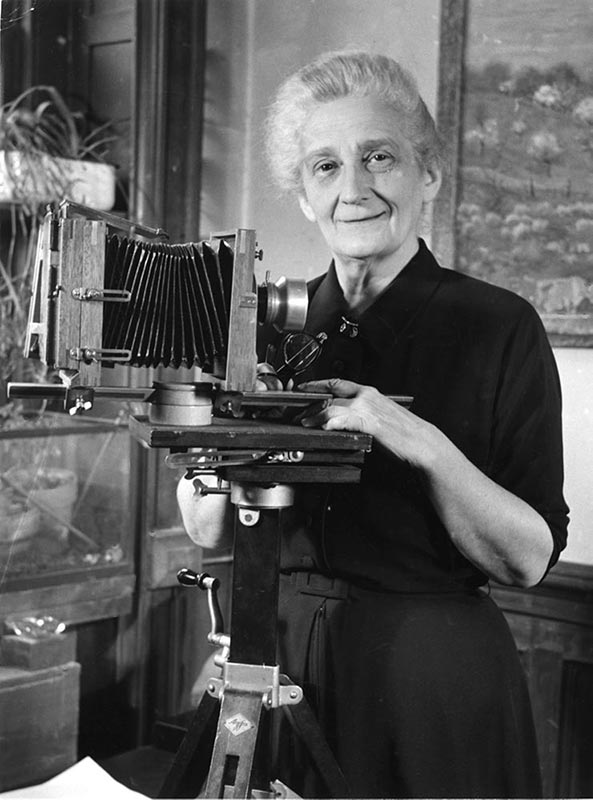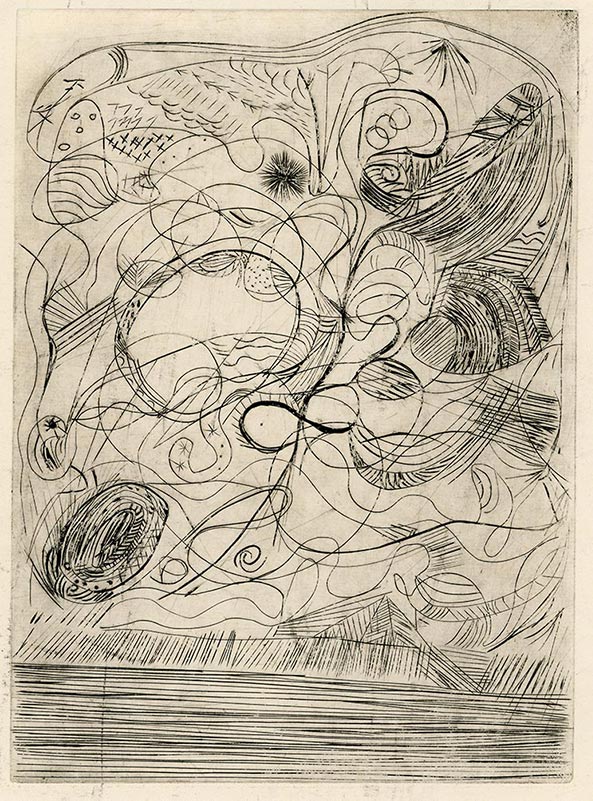45. Lotte Jacobi
| Life Dates | 1896-1990 |
| Place of Birth | Toruń, Prussia (now Poland) |
| Place of Death | Deering, NH, USA |
| Birth Name | Johanna Alexandra “Lotte” Jacobi |
The much-noted photographer Lotte Jacobi was involved with Atelier 17 during two distinct moments when the studio was in New York. Jacobi, born in West Prussia (now Poland), had a robust career as a portrait photographer in her family’s Berlin studio before immigrating to the United States in 1935. She first visited Atelier 17 around 1946 with her husband, Erich Reiss, when he was in ill health and seeking a stress-free hobby. Leo Katz, who had joined Atelier 17 in 1944, worked with Jacobi and Reiss on “photogenics.” For these camera-less photographs, Jacobi and Reiss shone a flashlight onto photosensitive paper, producing abstract effects.1 After Reiss’s death in 1951, Jacobi returned to Atelier 17 at the urging of Katz, who wanted to alleviate her mourning.2 She made a handful of copper-plate engravings, which are preserved in her papers at the University of New Hampshire.3 All are abstract and appear to be test plates, in which she experimented with techniques and methods of inking. She continued to visit Atelier 17 throughout the early 1950s, and she offered some studio members shows at her newly opened gallery space at 46 West Fifty-Second Street. Louise Nevelson, for example, exhibited her innovative Atelier 17 prints for the first time in January 1954 at Lotte Jacobi Gallery, and Jacobi also hosted a group show of Atelier 17 engravers in late 1954. Jacobi remained friendly with Stanley William Hayter, visiting the Paris workshop in 1963 and taking his portrait in 1973.4
Archives
Lotte Jacobi Papers, University of New Hampshire Library, Durham
Selected Bibliography
Moriarty, Peter. Lotte Jacobi: Photographs. Boston: A Pocket Book, David R. Godine Publisher, 2003.
Wise, Kelly. Lotte Jacobi. Danbury: Addison House, 1978.
Notes
- Jacobi first exhibited her photogenics at Norlyst Gallery in 1948, and Leo Katz wrote the introductory text to the catalogue. Jacobi evolved her process and eventually passed light over glass or twisted pieces of cellophane. A facsimile of Katz’s essay can be found in Peter Moriarty, Lotte Jacobi: Photographs (Boston: David R. Godine, 2003), 50–52. ↩
- Kelly Wise, Lotte Jacobi (Danbury, Conn.: Addison House, 1978), 12. ↩
- See thirty-five preserved engravings in Series XII: Miscellaneous, box 63, Lotte Jacobi Papers, University of New Hampshire Library, Durham. None of the engravings are signed or dated, so it is impossible to say definitely when they were made. Jacobi apparently worked in intaglio into the 1960s, one of which is illustrated in Wise, Lotte Jacobi, 13. Her name does not appear in the Grippe ledger, which likely means she was not officially a student in the 1952–54 period, but visited socially. ↩
- Stanley William Hayter to Helen Phillips, 17 April [1963], Helen Phillips papers, Paris. ↩

